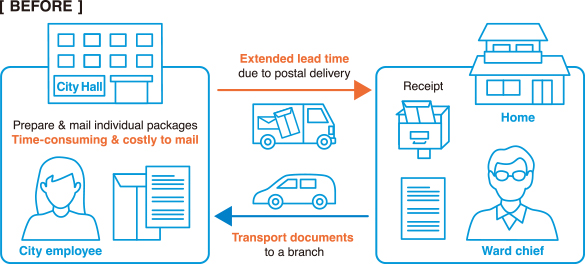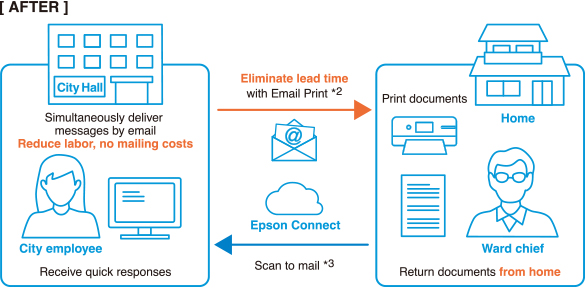Let's tackle social challenges through innovation with Epson!
Using Epson Connect to Communicate and Bridge the Digital Divide in Government DX
- With digitalization advancing, Shiojiri City and Epson conducted PoC tests to validate the feasibility of using Epson Connect to facilitate two-way communication between the city and the heads of community associations (ward chiefs) so that no one is left behind.
- Digitalizing the delivery of information from the city reduces mailing costs and speeds up the distribution of information. It also significantly reduces city employees' time and effort in sealing boxes and sorting materials.
- On the other hand, some residents (ward chiefs) have difficulty using smartphones or email to receive information. Epson Connect solves this problem by delivering information digitally on paper.
Epson conducted proof-of-concept (PoC) tests with Shiojiri, a city in Nagano Prefecture in Japan, for about two months, from December 2021 to February 2022, to improve two-way communication between the city and the heads of community associations. Digital citizen services must be palatable to all, regardless of the level of IT literacy. Here, we present an example of how Epson Connect1, a cloud service, facilitated communication and bridged the digital divide.
*See https://www.city.shiojiri.lg.jp/ for more information about Shiojiri.
■Hidefumi Kamimura (right)
Manager, Regional Development Section, Shiojiri City, Nagano Prefecture in Japan
■ Interviewer: Keiichiro Oyama (left)
P Strategic Planning Department, Seiko Epson Corporation

1 Epson Connect is a cloud service that uses the power of digital to connect people that are far apart from each other. Printers and multi-function printers connected to the Internet each have a unique email address and can enable printing and scanning from anywhere.
* Learn more about Epson Connect athttps://www.epsonconnect.com/
* Learn more about Epson Connect API at https://openinnovation.epson.com/en/developer/
Epson Connect dramatically reduced the burden on ward chiefs, who were constrained by time and place, and city employees, who were tasked with sorting, sealing, and mailing paper documents. The use of Epson's cloud service enabled smooth and easy communication.

Q: What did you tackle in the PoC tests?
Kamimura: In the Regional Development Section, we considered digitalization and digital transformation that involved the city organization and the local community. Shiojiri has a population of 67,000. The city is divided into 10 districts and 66 wards. A ward chief heads up each ward. The role of the ward chiefs is to deliver information from the city to the people in their wards. The city sends information to the ward chiefs about nine times a year. It took time and effort to print, sort, seal, and mail all the necessary documents and later call by phone to confirm that the packages were delivered. The ward chiefs had to complete and return certain documents by taking them to a local city branch office. We decided to consult Epson to see whether the power of digital technology could ease this situation, which led to the PoC tests.
We installed Epson Connect compatible multifunction printers in nine ward chiefs' homes and city hall.


*2 Epson Connect Email Print: Print photos and documents from anywhere simply by emailing files from a PC, smartphone, or tablet to the email address of a compatible printer.
*3 Epson Connect Scan to Mail: Use the control panel of a printer or scanner to scan images and send the data as email attachments.
Q: Before this trial, did you feel communicating with the ward chiefs was challenging?
Kamimura: In many cases, retired people in their 60s or 70s take on the job for a year or two, but the job becomes a burden for many, so it is not always easy to find a willing successor. If we could harness the power of digital technology to reduce the load, ward chiefs would have an easier time finding willing successors. That communication between the city and ward chiefs would go more smoothly.
We also considered using email and messaging apps to communicate with ward chiefs. Still, according to a questionnaire conducted in the past, only 15 of the 66 ward chiefs wanted to communicate via email. When asked why, they said they don't check their inboxes every day and don't want the hassle of searching for emails from the city. The Epson Connect email printing function delivers notices as printouts, so ward chiefs can visually tell that information has arrived.
Benefits of Epson Connect felt by the city and ward chiefs: A reduced burden and an always-on connection
Q: What did you learn from the PoC tests?
Kamimura: Besides dramatically reducing the amount of labor and expense involved in delivering documents, Epson Connect enables the city to speed up creating, finalizing, and delivering the documents.
Another critical point is that we eliminated miscommunication by communicating in writing documents instead of verbally over the phone. The ward chiefs informed us it is much easier to send replies from home instead of having to go to the trouble of visiting a branch office. The confusion and troublesomeness seem eased by the ability to take care of things as they arrive.
Installing multifunction printers in the ward chiefs' homes enabled two-way communication. We actively used these printers because they allowed us to efficiently and remotely deliver information that the old postal system could not have communicated - without worrying about the cost and bother of shipping. In the past, we could only connect with the ward chiefs by post, telephone, and time-limited meetings. Having multifunction printers that connect the ward chiefs' homes and the city facilitated communication and made people feel "connected."
Oyama: We had a case where printouts were delivered to students remotely through a private preparatory school's home learning support service. We received feedback from parents who said they feel more connected with the school and the teachers, which brought a sense of reassurance and a healthy sense of urgency. This suggests that printers can be used as IoT devices and communication devices in homes and daily life.

Bridging the digital divide (IT literacy gap): Digitalization that is attentive to individual needs
Q: What challenges do you face in advancing the digitalization of citizen services?
Kamimura: As a government official whose job is to provide citizen services, we cannot unilaterally go forward on digitalization. We need a means of communication that is attentive to the needs of each person, regardless of how comfortable they are with digital technology.
Ward chiefs and the citizens they serve have different levels of IT literacy. Nowadays, even many seniors use chat apps like LINE, but how many know how to attach files, open files, or save them in the cloud for viewing? The city needs to grasp the level of each person. We also hold seminars for residents, but these can only go so far.

In this test, the Epson Connect cloud service was used to allow printers to be used like digital faxes. Information is delivered using the power of digital technology, but paper can still be used to convey the information. It was also an advantage to be able to see all the information at once without being limited by the screen size of the device.
Advancing digitalization across the community by changing the mindset through successful experiences

Q: Lastly, please tell us about what the future holds.
Kamimura: Besides introducing digital solutions that connect the city and ward chiefs, I would like to advance digitalization across the board in citizen services. Like many people, I didn't understand the benefits of messaging apps until recently. For people who are not familiar with digital technology, learning to use new apps and tools can be intimidating, which we fear could cause them to reject them. The city doesn't have the wherewithal to provide digital education to all residents. Still, I hope that if we can gradually shift to the digital delivery of information to ward chiefs, this will eventually change the entire community's mindset. I think people need to experience success for this to happen. For example, if senior citizens find that using digital tools allows them to communicate at any time with their grandchildren who live far away, that could be a breakthrough in accepting new digital tools and services. These PoC tests validated the benefits of Epson Connect, and I want to continue using it in the Community Development Section and across the board in citizen services.
Q: Is there anything you hope to see from Epson?
Kamimura: A lot of Epson employees live in Shiojiri. Shiojiri has more young families than any other municipality in the prefecture, so I hope that Epson will adopt policies that assist young families and encourage them to settle here. I also hope to see Epson provide products and services that become a part of daily life.
Shiojiri is attempting to digitalize citizen services for residents with varying IT literacy levels. Shiojiri is not alone in this; municipalities across Japan face the same challenges. Epson will accelerate its efforts to coexist with people who need to become more familiar with digital technology and realize sustainable lifestyles in more rural areas outside the big cities.
Interview conducted: December 2022
All information on organization names, affiliations, titles, and reported content was correct as of the time of the interview.



